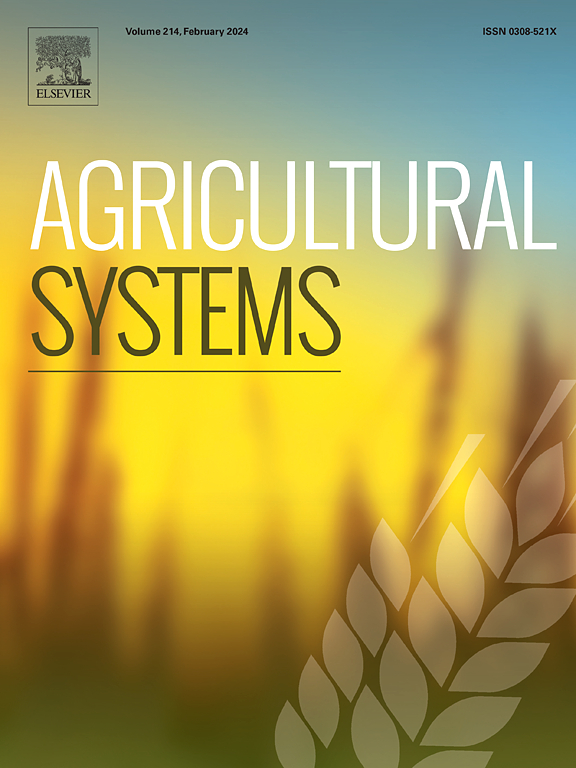Simulation study of the production efficiency of family-type agricultural management entities under regulation measures on farmland: Three-stage super-SBM model considering greenhouse gas emissions
IF 6.1
1区 农林科学
Q1 AGRICULTURE, MULTIDISCIPLINARY
引用次数: 0
Abstract
Context
Black soil farmland protection is a necessary measure in China to achieve sustainable, high-quality farmland development. Biochar, as a new type of soil amendment, has been shown to reduce greenhouse gas emissions and increase crop yields. However, few studies have addressed the widespread application of biochar from a productivity perspective.
Objective
The purpose of this study was to assess the productivity of farmland regulation measures to provide information that can be used for monitoring and comparison. The strengths and weaknesses of different tillage practices in soils with different gradients of biochar application and further targets for improvement were determined.
Methods
In this work, a three-stage data envelopment analysis (DEA) approach combined with a superefficiency measurement (Super-SBM) model with slack was used to study the production efficiency of 40 experimental plots at the Acheng Experimental Site, using soil greenhouse gas emissions as an undesired output. The dynamics of productivity in the experimental plots were explored after the influences of the external environment and statistical noise were removed.
Results and conclusions
The results showed that biochar could significantly inhibit soil greenhouse gas emissions, and deep tillage and the application of 500 kg mu−1 biochar resulted in the greatest emission reductions. Tillage and the market price of crops increase on-farm productivity by influencing the input redundancy of biochar and seeds. Family-type agricultural management entities can optimise environmental protection and economic efficiency by selecting different farmland regulation measures, which include the following: 1) Deep ploughing and the application of 500–558.74 kg mu−1 biochar for hard-grain corn are suitable for family farms. 2) Deep ploughing and the application of 500–504.72 kg mu−1 biochar for sticky corn are suitable for large-scale growers. 3) Deep ploughing and the application of 0–40.43 kg mu−1 biochar for sticky corn are suitable for traditional farmers.
Significance
This study provides feasible options for the sustainable and green application of biochar under different agricultural management conditions. It can be used as a general pattern and extended to other agricultural management entities that show inefficient agricultural production.

农地管制措施下家庭式农业经营主体生产效率模拟研究——考虑温室气体排放的三阶段超级sbm模型
黑土农田保护是中国实现农田可持续、高质量发展的必要措施。生物炭作为一种新型的土壤改良剂,具有减少温室气体排放和提高作物产量的作用。然而,很少有研究从生产力的角度讨论生物炭的广泛应用。
本文章由计算机程序翻译,如有差异,请以英文原文为准。
求助全文
约1分钟内获得全文
求助全文
来源期刊

Agricultural Systems
农林科学-农业综合
CiteScore
13.30
自引率
7.60%
发文量
174
审稿时长
30 days
期刊介绍:
Agricultural Systems is an international journal that deals with interactions - among the components of agricultural systems, among hierarchical levels of agricultural systems, between agricultural and other land use systems, and between agricultural systems and their natural, social and economic environments.
The scope includes the development and application of systems analysis methodologies in the following areas:
Systems approaches in the sustainable intensification of agriculture; pathways for sustainable intensification; crop-livestock integration; farm-level resource allocation; quantification of benefits and trade-offs at farm to landscape levels; integrative, participatory and dynamic modelling approaches for qualitative and quantitative assessments of agricultural systems and decision making;
The interactions between agricultural and non-agricultural landscapes; the multiple services of agricultural systems; food security and the environment;
Global change and adaptation science; transformational adaptations as driven by changes in climate, policy, values and attitudes influencing the design of farming systems;
Development and application of farming systems design tools and methods for impact, scenario and case study analysis; managing the complexities of dynamic agricultural systems; innovation systems and multi stakeholder arrangements that support or promote change and (or) inform policy decisions.
 求助内容:
求助内容: 应助结果提醒方式:
应助结果提醒方式:


